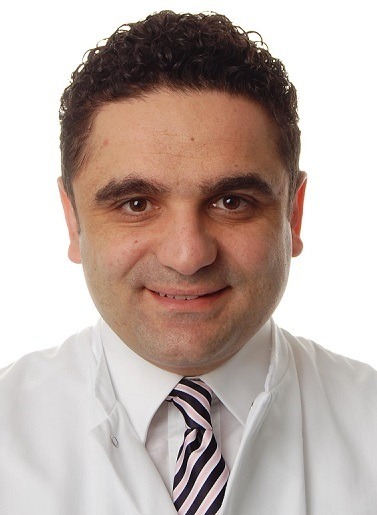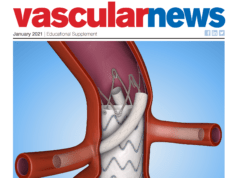
“Systematic scrutiny” of the large patient cohort in the PERICLES registry has resulted in a new classification describing three distinct patterns of chimney endovascular aneurysm repair (chEVAR) gutter-related endoleaks and technical modifications for their treatment, according to an article published in the Journal of Endovascular Therapy.
Konstantinos Donas, St Franziskus Hospital Münster, Münster, Germany, and colleagues explain that chEVAR treatment is “gaining popularity and applicability” in the treatment of juxtarenal aortic aneurysms in cases of short or absent infrarenal necks; anatomies that exclude treatment with standard EVAR. However, “the inevitable creation of gutters that result from the interaction of the chimney graft with the main aortic stent graft,” represent a potential weakness in the procedure, as these gutters can become a conduit for type Ia endoleak formation.
PERICLES collected the global transatlantic experience of 13 European and US vascular centres, reporting on 517 patients with complex aneurysms treated with EVAR and chimney parallel grafts. Overall, 6% of PERICLES chEVAR patients had a type Ia endoleak at completion angiography, with a rate of persistent endoleaks of 2.9% at a mean 17.1 months of follow-up.
Close review of the postoperative computed tomography angiograms of these persistent endoleak patients revealed distinct types and patterns of chEVAR-related type Ia endoleaks. This finding, write the authors, forms the basis of the newly-proposed classification. They explain, “It is hoped that these observations will lead to development of new treatment algorithms for effective management of chimney-related endoleaks and, in some cases, to prevent them from occurring in the first place.”
Of the three identified patterns, the first—Pattern A—was excessive stent graft oversizing. The authors write, “Stent-graft oversizing by >30% compared with the diameter of the suprarenal aorta or malapposition to the aortic wall often leads to infolding of the endograft in the neck area and consequent type Ia endoleak. The observed cases of pattern A did not exhibit significant enlargement of the aneurysm sac, so conservative management of these patients with close imaging surveillance alone may be appropriate.” If an intervention is deemed necessary, the authors suggest that reasonable first steps would be embolisation using liquid agents or kissing-balloon dilation, with simultaneous inflation of balloons inserted in the main stent graft and inside the chimney graft.
Pattern B looked at endoleaks caused by excessive gutter formation as a result of insufficient stent graft oversizing. “For instance, performing chEVAR with a 36mm diameter aortic stent graft when the pararenal seal zone measures 31mm in diameter risks creating large gutters and a poor seal since the oversizing is <20%, leaving insufficient excess stent graft material to wrap around the chimney graft,” Donas and colleagues write. “Patients with pattern B endoleaks appear to have a proximal seal zone of sufficient length (ie. at least 20mm); however, minimal stent graft oversizing leads to the formation of excessive gutters and endoleaks. This is especially problematic when placing multiple chimney grafts.”
The authors acknowledge that the minimum amount of oversizing necessary is still controversial, and they hope to better delineate optimal sizing with further evaluation of PERICLES. That said, they do suggest that “In general, 20–30% oversizing is recommended for standard chimney grafts to minimise the gutters without excessive infolding,” while the necessary amount of oversizing is less if the chimney graft is moulded into an oval or lens shape. Post-implantation management of Pattern B endoleaks can be achieved through gutter embolisation (using plugs, coils, and/or liquid agents), but expansion of the seal zone may also be required, Donas et al report.
The third pattern—Pattern C—is the presence of a short sealing zone in chEVAR resulting in early type Ia endoleak or predisposing to downward migration of the abdominal device and delayed type Ia endoleak. Progressive degeneration and dilatation of the neck in a short seal zone can also have the same results, the authors note. This pattern is illustrated in Figure 3, in which a tube endograft migrated after a single chimney graft placement in the left renal artery. The endograft was in a para-anastomotic aneurysm following open surgical repair four years previously, and the chEVAR seal zone measured 9mm in length. In cases such as this, Donas and colleagues report, the proximal fixation-seal zone must be extended upward, with implantation of additional chimney grafts as needed.
In summarising their findings, the authors encourage readers to “scrutinize their own chEVAR gutter-related type I endoleaks and determine if they show some of the same patterns.” Concluding, they suggest that “ultimately, as experience grows, these concepts and new insights will hopefully lead to better techniques and optimal graft sizing strategies that will minimise their occurrence and help implement best management approaches when the problem is detected after EVAR.”













